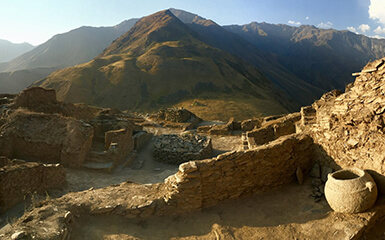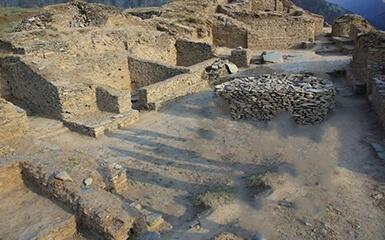Kok Gumbaz
Ajina Teppa
Ancient Panjakent
Anzob Tunnel
Beshkent Qala
Childukhtaron
Khazrati Shokh
Mug Teppa
Gharm Chashma
Hisor Historical
Haji Yaqub mosque
Hazrati-Bobo complex
Lake Iskanderkul
Kalai-Khumb
Karatag
Karon
Khishtin caravanserai
Khorog
Khulbuk
Lake Karakul
Abdullatif Sultan
Madrasai Kuhna
Abu Abdullah Rudaki
Khoja Mashhad
Khudoyor Valami
Makhmudi Azam
Mir Sayyid Ali Hamadani
Muhammed Bashoro
Sheikh Muslihiddin
Nurek Mountain Lake
Pamir
Sarazm
Sari-Khosor
Seven Lakes
Shirkent
Chiluchorchashma
Takht-i Sangin
Karon – the real lost city

Karon is a Zoroastrian city in Darvaz, located 6 km from Kalai-Khumb and 1 km from the village of Ruzvay. It was discovered in 2012, which was a great event in world archaeology. In the ancient city of Karon, which was supposedly formed 4 thousand years ago, Tajik archaeologists have discovered an observatory.
From year to year after this archaeological discovery, the town "expanded". Now there are found temples, fragments of a five-domed temple of fire, a temple of water, two temples of wind, a windmill, a fragment of the holy book of the Zoroastrians "Avesta", the remains of a large playground for playing polo (chavgonbozi), halls, administrative and residential buildings.
The ruins of a fortress were also found in the ancient town, which is supposed to be one of the largest mountain “residences” of local kings.
Locals knew the existence of Machu Picchu known as the “Lost City of the Incas”, since beginning; its new name was nothing more than an archaeologist's marketing gimmick. However, in Tajikistan's Gorno-Badakhshan Autonomous Region (GBAO), a vast and remote region dominated by the towering Pamir Mountains, the population density is only one person per 2.5 square km. GBAO is big and wild enough for a few local residents to completely lost the 100+ hectares of archaeological site.
Karon is on a steep cliff above the Pamir Highway, embracing the border between Tajikistan and Afghanistan. Climbing is the first challenge to reach the site. A challenging track opened up on the mountainside, but the corners are so tight that even a 4×4 has to make three-point turns to get up.
At the top, it was found that the flat field was used as a polo field. Karon's castle overlooked the polo field. Archaeologists peeled off the soil layer by layer, revealing streets, walls and rooms. The people living here made their money from the land trade, as well as gold mining and processing.
The polo field was 30m wide and 50m long. The monarch watched from a high platform and the tribunes around it had a capacity of 10,000 spectators. Today, you need to invite everyone within a 100 km radius of Karon to fill these stands. To justify a hippodrome of this size, ancient Karon would have to be a very large city indeed.

